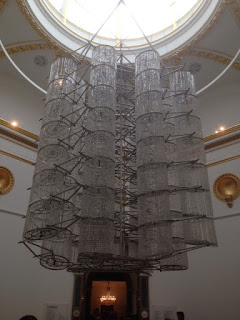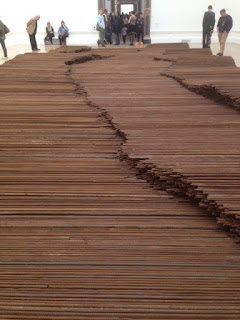 |
| 'Brixton' 8"x10" oil on canvas board |
Another year draws to a close and I can't shake thinking there is a parallel universe where I am making a living as an artist, painting that is . From time to time I catch myself thinking things like 'Right about now I would be getting into portraiture' or 'What would happen if someone commissioned a mural? ' People always say I must feel fortunate but I don't because along with a modicum of talent, an artist must must must have an entrepreneurial risk-loving nature that I do not possess. It's a ballsy thing to be a professional artist. I despise self-pity and yet, here I am. Full of it.
So before I dig myself deeper let's switch to the good stuff, what have I learnt from landing my sorry self on these parts with their different kind of weather and light. A sense of place.
 |
| 'Horse Guards Rd" 8"x10' oil on canvas |
A sense of place is important to me right now may because as a two-time immigrant, I am sick and tired of travel for work (no, not the leisure kind, that one is fun.)
My palette has changed. I have noticed Emerald Green creeping
out of its shell a and making it into the walls of brick buildings while
that lazy painter's friend, Mr. Sap Green, hasn't been seen for months. Then
Ivory Black slipped into my box and I found myself often reaching out
for Payne's Grey in my watercolor set. Lemon yellow with its cool
acid whisper seems to be gaining over hearty ol' Cadmium. Alizarin
camps on my skies instead of the brighter Indian Yellow of sunnier days. Ocher with its perfect grey tonal value buttresses many a passage. Some
colors have even morphed into something else: I recall the days when
Transparent Oxide Browns were my go-to for creating transparent shadows
and undefined corners. These days it just lends its warmth to different
flavors of gray. In short, I am finally painting London.
 |
| 'Knightsbridge' 8"x10' oil on canvas |
My few successes capturing the luminosity of California were hard
earned. I came to London a bit apprehensive that I wouldn't find the
landscape stimulating enough, that I had worked so hard at creating vibrant color and vivid light just to see it discarded. But once in England clouds showed up with their incredible variety ...and then it started raining. I knew right away my fears were misplaced. That was
painting gold right there along with muscular trees, softer light and lots of interesting people and endless bouts of the flu. So I carried on adjusting
and adjusting to my new surroundings, letting the palette build itself.
Other things started to happen
besides the pigments reshuffle. In the bright Los Angeles light, I
favored describing the volumes through saturated contrast often letting
either the light or the shadow carry the weight of detail but never
both. I'd let the shade be transparent and act as a breathing space
while the sun-drenched areas lived apart letting the magic happen in the borders between light and shadow. Under the British light, the local colors
become explicit, matter-of-fact, shade is a question of gradations and shape is described
by a continuum of edges and transitions.
 |
| 'Harrods at Night" 8'x10' oil on canvas |
I've also learned quite a bit by observing what the native artists do. True, nowadays most art is universal, techniques could be a matter of taste rather than one of location but visiting some of the shows at The Mall galleries (a good place to see proper painting without any sad claims to be 'questioning issues of social transcendence, gender roles or inner turmoil ' or any such nonsense) I have always been struck by the air of 'family' the art emanates. And not only because British artist overwhelmingly favor soft bright colored frames instead of dark or gold. It's hard to put the finger on one thing and I've mentioned this before but British art has a thing for accuracy and another thing for proper draftsmanship that is quite refreshing. On the other hand, a lot of the art lives in a low saturation content spectrum, aka a certain 'chalkiness', as if the painting hasn't left behind the reliance on the drawing.
 |
| 'Tottenham Ct' 12"x10" oil on canvas |
 |
| 'Whitechapel' 10"x8" oil on board. |
When I was about 19 years old, I used to think the Flemish masters like Van Eyck, Memling, etc.. were just odd fastidious
painters with a very particular taste for thin trees, sad skies and
fish-eyed pale subjects. Then I traveled to Belgium and I was shocked, shocked! that the landscape and the people looked exactly like the Flemish portraits I had studied in school. The poplars were thin, the skies and the streets of Brussels awash with cool light and pale alabaster people. Turns out the Flemish masters fitted right in and had been faithful to a fault.
Paintings match the environment. It is logical of course. And it is a sign of a great talent that one might recognize the light from the flat application of pigments. Think of a California Impressionists like Rose or Puhuff versus a Wyeth or Hopper. Even within environments: I can see the candlelit nocturnal Rome in Caravaggio versus the diaphanous Tuscan softness of Raphael. Even cosmopolitan Sargent who traveled the world so much and yet only seemed to able to capture the color of money... (I'm joking!).
Now if I can only stay put in one place so that I can travel. That would be the bee's knees.












































